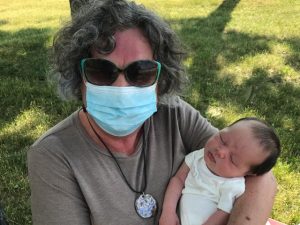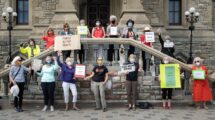A bewildering question of weighing risks and benefits
Intentional Grandparenting
Mary Jane Sterne and Peggy Edwards
 When I worked in public health, we were constantly dealing with the concept of risk reduction to protect health, and the idea of balancing risk and benefits, especially in the face of an infectious
When I worked in public health, we were constantly dealing with the concept of risk reduction to protect health, and the idea of balancing risk and benefits, especially in the face of an infectious
disease. Enter COVID-19—the global pandemic we knew would come sometime, but never dreaming it would be in our lifetime.
In retirement, I never imagined that the debate about risks and benefits would become central to my role as a grandparent, which is clearly the best profession I have ever had. We all hoped the crisis would be short-lived. Now seven months have elapsed, and as one grandfather told me, “It’s been confusing and difficult to know what to do, but we love our grandkids and we find ways to stay connected.”
Early on when we first became aware of the pandemic and the serious consequences for older people, grandparents everywhere were sad but smart. We switched to online contact with the grandkids, enjoying chatting, games and even eating dinner “together” through FaceTime, Zoom and other digital platforms. Some were able to help with home schooling doing reading, math, and social studies projects online with their grandchildren.
I talked with several grandparents who admitted (and promised me to secrecy) that they had gone outside of public health warnings about risk, because their role as caregivers was essential to the health and well-being of their adult children and grandchildren. “My daughter is a single parent of two,” explained one grandmother. “She and the children could not survive without my help with caregiving. She must work to feed the family and even if she could afford it, daycares are closed.”
Another grandmother, whose son was going through a difficult divorce found herself torn between the decision to go and help him and her two young granddaughters, or to stay away for the sake of safeguarding her own health. “Fairly quickly I understood that my role as a helping caregiver gave me meaning in life,” she said “and that we need to be compassionate with ourselves and our family in these difficult times.”
Some grandparents have had their adult children and grandchildren return home because of the pandemic. Dorothy and Paul welcomed their daughter and her two young children home from Mexico, where the schools were closed indefinitely and there was little access to testing and treatment. After 14 days of strict isolation, the grandkids settled in and startedschool in Ottawa, up the street at the same school
their Mom had gone to as a child. “In my mid seventies, I never thought I’d be making school lunches again or struggling to find the energy to keep up with an active five-year-old,” says Dorothy. “We are aware of the risks to us, but the benefits—for the children, their Mom and us are worth it. After all, this is what family is about.”
As the good weather arrived, we saw that proper public health measures (hand washing, wearing masks and physical distancing) worked to “flatten the curve” and reduce community transmission. We progressed to the idea of “social bubbles” wherein we could create a bubble of 10—grandchildren and other family members and friends who agreed to keep close contacts within this realm and to not interact if anyone had symptoms of COVID-19 or were feeling unwell.
We enjoyed outdoor meetings in backyards, front laneways and parks, keeping our distance and mostly not snuggling with our grandchildren. This worked to some extent, with older grandkids. Not so much with toddlers and preschoolers. One grandmother described her back garden visit with her 4-year-old grandson Fenton and his parents.
“Fen knows he mustn’t come too near us and has actually found a thin stick about two metres long, which he uses periodically to check his distance. Last time we visited, as we were saying good-bye, he left his parents’ side, ran to us and quickly hugged my leg and then his Granddad’s leg. Then, saying nothing and without looking at us, he ran back to his parents. His action touched me deeply.”
“It just isn’t right,” said another grandmother. “Very young children do not understand why we cannot hug and kiss them like we used to, even if they have been told about the virus and how to stay safe. Grandparents are an important source of unconditional love and visa versa. My granddaughter is hurt and confused. It breaks her heart and mine too.”
After seven months, we entered the “new normal” and the realization that we need to continue to employ different and creative ways to stay connected with our grandchildren. We also learned more about how isolation and a lack of physical touch affects children and older people. In fact, a lack of touch and connections with those you love is linked to mental and physical health problems and even earlier death. For children, barriers to bonding and physical touch can seriously compromise their well-being both now and in the future. It’s a tricky balance, no doubt.
Tips for safe, effective grandparenting during a Pandemic
Virtually with no personal face-to-face contact
• Set up a regular time for visits when your grandchild will be at his or her best and suits the family schedule. Keep the interaction short, especially with younger children. Don’t take it personally if grandkids (of all ages) seem distracted or don’t want to participate.
• Be prepared. Think about what you will talk about and some questions you might ask. At the same time, be sure to let the kids tell you things they want to talk about. Consider sending activities (e.g. a riddle or family quiz) ahead of time for discussion on the call.
• Reading books and silly poems, singing a song or making faces are fun to do with very young children, Try developing a sign language message (e.g. to display I love you—point to your nose, hug yourself and then point to your grandchild).Just imagine how one day far ahead you can send this message secretly at his wedding …
• Write and mail them letters and encourage them to write back.
• Consider asking the parents if older kids can be on the call themselves, so you can talk about things in confidence, like you used to do when you were able to be alone together face-to-face.
Physical distancing from six feet away
• Plan your porch, garage or back yard visits. Dress for the weather and bring your own chairs and food and drinks.
• Meet at a park to build a snowman or snow fort, bird watch or play active games. Bring a thermos of hot chocolate and small disposable cups
Visiting in person, inside the social bubble, or living with them
• If you decide to visit with grandkids, follow proper protocols: frequent hand washing, wearing a mask, distancing and avoiding hugs and kisses. Bring children back into your face-to-face life one family at a time. This is not the time to host a big gathering.
• If you have grandchildren living with you, follow proper protocols for staying safe within your household unit, in meeting with other families and going to school.
Balancing risks and benefits is a personal and family decision
In the end, it does come back to the public health balance of risks and benefits. The risk of serious complications from contracting COVID-19 are high if you have chronic health problems that compromise your immune system, or if grandchildren and their parents are exposed to unsafe environments. But if you can be with your grandchildren in safe environments, the emotional and mental health benefits are enormous for both generations.
At the end of the day, it is your decision, in consultation with the parents about when, why and how you will be with your grandkids. Here are some ideas to guide your decision making.
1. Write down the risks and benefits and discuss them together. If there was ever a time for open communication, it is now. Reassure
your grandchildren (and their parents) that you are following public health guidelines and taking steps to reduce your risk. This is especially important for older grandchildren who may feel a strong obligation to protect you. Let them know how important the benefits are to you and the level of risk you feel comfortable with.
2. Avoid judging other people’s decisions, including friends and your adult children. Everyone in the arrangement has to feel comfortable. Talk about your levels of comfort. This goes both ways. Part of your agreement with your adult children is that you will not judge or criticize their decisions, but if you that certain choices make you apprehensive, you need to be free to say so and to step back if risks outweigh benefits.
3. Try to meet outdoors. Transmission is unlikely outside, as long as we keep six feet apart.
4. Consider no face-to-face contact (except perhaps outdoors with physical distancing and wearing a mask) if you have chronic diseases (such as asthma or diabetes) or a compromised immune system. People with these conditions are more likely to become severely ill if they contract the coronavirus. It goes without saying that we also need to protect infants and children who may have been born with or developed health problems that compromise their health.
5. Consider no face-to-face contact if the parents have to work in environments that could expose them to the virus. Be sure that the children’s schools or daycares are strictly following safety protocols. Never visit if anyone has signs of illness including a fever, cold, runny nose, extreme fatigue or flu-like symptoms.
6. Continue to take basic preventive steps: getting your flu shot, hand washing, physical distancing, and mask wearing in public places. We all look forward to a future where we can once again express our love and hopes for our grandchildren in a hands-on way. In the meantime, we will make the best decisions we can at a given moment in time. As we head into winter, we will continue to revisit and revise our protocols, rules and conversations about how we stay connected with our grandchildren. I know you will do what is best for the well-being of everyone.
How are you handling the risks and benefits of grandparenting during a pandemic? Write to Peggy at wanderingpeggy@me.com.We’d love to hear from you and share your wisdom.
Peggy Edwards and Mary Jane Sterne are best friends and the authors of Intentional Grandparenting: A Boomer’s Guide (McClelland and Stewart, 2005). Available from amazon.ca and Chapters.Indigo.ca. The authors live in Ottawa and have 23 grandchildren and seven great grandchildren between them.






